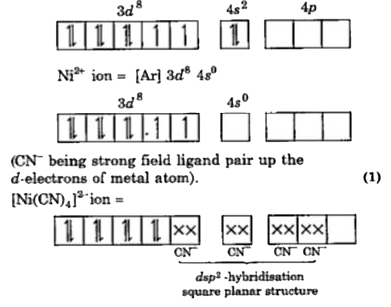Account for the following on the basis of valence bond theory.
(i) [Ni(CN)4]2− is diamagnetic and square planar.
(ii) [NiC4]2− is paramagnetic and tetrahedral.
Outer electronic configuration of 28Ni atom = [Ar]3d84s2

It involves dsp2 hybridisation and has square planar geometry. In this complex, each of the hybridised orbitals receives a pair of electrons from a cyanide ion. The complex is diamagnetic in nature as it has no unpaired electrons.
In the complex ion [NiCl4]2− nickel is in +2 oxidation state and has the electronic configuration 3d8 also. But Cl− being weak field ligand cannot cause pairing,

Four pair of electrons one from each Cl− ion occupy the four hybrid orbitals. Thus, the complex has tetrahedral geometry (sp3) . Paramagnetic in nature as it has two unpaired electrons.
Similar Questions
How will you account for the indicated molecular geometry of the following compounds in terms of valence bond theory ?
[ArCl4]− is square planar while [GaCl4]− is tetrahedral .
View SolutionExplain on the basis of valence bond theory that [Ni(CN)4]2− ion iwth square planar structure is diamagnetic and [NiCl4]2− ion iwth tetrahedral geometry is paramagnetic.
View Solution
Knowledge Check
Give reason for the statement [Ni(CN)4]2− is diamagnetic while [NiCl4]2− is paramagnetic in nature .
AIn [NiCl4]2− no unpaired electrons are present while in [Ni(CN)4]2− two unpaired electrons are presentBIn [Ni(CN)4]2− , no unpaired electrons are present while in [NiCl4]2− two unpaired electrons are present .C[NiCl4]2− shows dsp2 hybridisation hence it is paramagnetic .D[Ni(CN)4]2− shows sp3 hybridisation hence it is diamagnetic .Give reason for the statement [Ni(CN)4]2− is diamagnetic while [NiCl4]2− is paramagnetic in nature .
AIn [NiCl4]2− no unpaired electrons are present while in [Ni(CN)4]2− two unpaired electrons are presentBIn [Ni(CN)4]2− , no unpaired electrons are present while in [NiCl4]2− two unpaired electrons are present .C[NiCl4]2− shows dsp2 hybridisation hence it is paramagnetic .D[Ni(CN)4]2− shows sp3 hybridisation hence it is diamagnetic .Nl(CO)4is diamagnetic, [NlCl4]2− and [Ni(CN)4]2− are paramagnetic
AI , II and IIIBII ,III and IVCI,III and IVDAll four are true
Explain on the basis of valence bond theory that [Ni(CN)4]2− ion with square planar structure is diamagnetic and the [NiCl4]2− ion with tetrahedral geometry is paramagnetic.
View SolutionHow do you account for the indicated molecular geometry for the following compounds in terms of valence bond theory. [Aucul_(4)]^(-) - square-planar, [Fe(CN)6]3− - octahedral, [GaCl4]− tetrahedral, [Nicia) tetrahedral
View SolutionHow do you account for the indicated molecular geometry for the following compounds in terms of valence bond theory. [Auc––––––(4)]− - square-planar, [Fe(CN)6]3− - octahedral, [GaCl4]− tetrahedral, [Nicia) tetrahedral
View Solution[NiCl4]2− is paramagnetic while [Ni(CO)4] is diamagnetic though both are tetrahedral. Why?
View Solution[NiCl4]2− is paramagnetic while [Ni(CO)4] is diamagnetic though both are tetrahedral. Why?
View Solution
